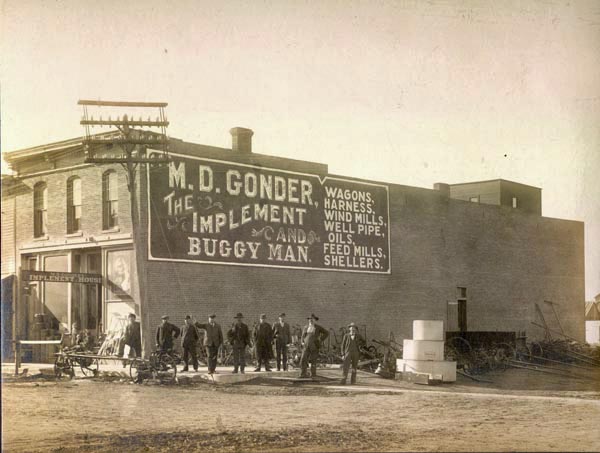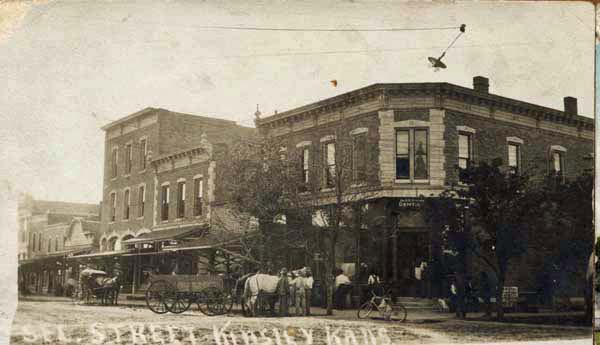When I learned this week that Trick-or-Treating did not really take hold of the Halloween holiday until the 1930s, I wondered how people celebrated here before that? By reading the old newspapers, I discovered there were plenty of parties and pranks.
Parties were held in private homes, churches, at the high school, the opera house, and in club rooms. Decorations were much like today, except the Ketelson home did use one particularly spooky effect. “The rooms were lighted with candles set in half pumpkins… while the electric light bulbs were shrouded in Jack-o-Lantern faces. When the witches’ dance occurred, these lights were lowered and ghostly figures pranced around a table from which a bowl of blue-flaming alcohol cast a lugubrious light. (Kinsley Mercury, 11-1-1907)
Parties had traditional refreshments of popcorn balls, apples, pumpkin pie, roasted marshmallows, and cider. One different tradition was not unlike the Christmas King cake. “In the Hallowe’en cake, Miss Pearl Wire found a silver dime, Master Hugh McCanse a gold ring, and Miss Edith Colver a thimble. (Kinsley Graphic, 11-2-1900)
Costumes were simpler as most donned a ghostly sheet or only wore a mask.
We would recognize the games of bobbing for apples, apples tied to a string, and seeing how many words can be made from the letters in “Halloween”. But every party seemed to require an old witch, a gypsy or some mysterious fairies telling fortunes by examining tea leaves or coffee grounds in a saucer, by blowing out candles, or by interpreting acorns floating in a pan of water.
Young ladies at the party could find out who they would marry by walking down the cellar stairs backwards at midnight while holding a candle and mirror. Each would strain to see her future husband’s face reflected in the glass.
Or a young woman could go to the center of the most remote room in the house and eat an apple just as the clock was striking twelve. As she timidly waited in the dark, someone would appear and give her a kiss. According to The Valley Republican, “Both these experiments were reliable and satisfactory.” (11-28-1878)
Adults had their own entertainments including dinners, dancing and card playing. At a party hosted by Judge and Mrs. Vandervert, “A number of amateur poets were developed who had no license but wrote poetry just the same. There were various styles of poetry, the judicial, editorial, pharmaceutical, transportation, banking, and last but not least the sentimental written of course by the ladies.” (Graphic, 11-8-1895)
The Knights of Pythias ladies used a unique fund raiser at their Halloween dinner ball which I do not think would go over very well today. “Each lady was given a number, likewise the gentleman, and those having corresponding ones were partners for the supper. Each gentleman was then requested to escort his partner up to a pair of scales standing by the doorway leading into the dining hall, and be weighed, the gentleman paying the difference between their weights at the rate of two cents a pound for their suppers. It was noticed one of the heaviest men present was unfortunate in getting the very tiniest lady there and one of the very light weight gentleman got one of the very heaviest ladies.” (Graphic, Oct. 28, 1920)
I hesitate to discuss Halloween pranks for fear of putting ideas into younger heads, but then, I am sure some readers can remember engaging in similar less harmful antics.
In 1889 the editor of the Graphic warned, “We have heard several bands of youngsters laying out plans for Halloween. Citizens had better take everything moveable in the house and then tie the house down.”
According to the Graphic, inclement weather cut down on the pranks in 1903. “A few people missed their gates, found their outbuildings overturned and buggies in the creek, but the actual cash damage was comparatively slight.”
Weather must have been better in 1905 as the Graphic paints a vivid picture of a more typical dawn on November 1. “The main street of the town looked like the display of machinery at the county fair, all kinds and descriptions of machinery being scattered about the street. A hay derrick was in the street in front of Gonder’s; a windmill tower on the sidewalk in front of the post office, etc. The principal trouble with this sort of amusement is that the parties who destroy property are never made to pay for the damage.”

at 220 E. Sixth St. Currently it is a vacant lot.

An article appearing in the Mercury that same week ended with “However, the town still stands and we ought to be thankful.
”I think the sheriffs did their best to curtail destructive activity and sometime entered into more innocent fun.
“About eleven ghosts were serenading on Main street when they ran into the night sheriff, Will Pierce, and decided they would have some fun. They took possession of the sheriff and took him to the confectionery where he had to treat the bunch. Although he seemed somewhat excited, the ghosts succeeded in calming his fears and left him a little nervous after his trying experience with so many ghosts.” (Graphic, 11-7-1912)
In 1920 the Graphic reported, “The boys around town decided to make an implement display at the high school in celebration of All Saints evening. They say you could find every agricultural implement known to man on the grounds when school opened Monday morning, arranged in what might be called “a hit-and-miss effect.” No particular damage was done….”
I want to encourage all of you to spend some time reminiscing about Halloween when you were a child. Tell your memories to your kids and grandkids; better yet, write them down for posterity. Have a safe Halloween, filled with spooky fun and please, only harmless tricks.
